
Chiricahua is a band of Apache Native Americans.

Geronimo was a leader and medicine man from the Bedonkohe band of the Ndendahe Apache people. From 1850 to 1886, Geronimo joined with members of three other Central Apache bands – the Tchihende, the Tsokanende and the Nednhi – to carry out numerous raids, as well as fight against Mexican and U.S. military campaigns in the northern Mexico states of Chihuahua and Sonora and in the southwestern American territories of New Mexico and Arizona.

The Apache Wars were a series of armed conflicts between the United States Army and various Apache tribal confederations fought in the southwest between 1849 and 1886, though minor hostilities continued until as late as 1924. After the Mexican–American War in 1846, the United States inherited conflicted territory from Mexico which was the home of both settlers and Apache tribes. Conflicts continued as new United States citizens came into traditional Apache lands to raise livestock and crops and to mine minerals.
Lozen was a warrior and prophet of the Chihenne Chiricahua Apache. She was the sister of Victorio, a prominent chief. Born into the Chihenne band during the 1840s, Lozen was, according to legends, able to use her powers in battle to learn the movements of the enemy. According to James Kaywaykla, Victorio introduced her to Nana, "Lozen is my right hand ... strong as a man, braver than most, and cunning in strategy. Lozen is a shield to her people".
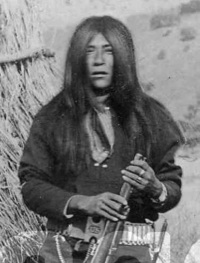
Massai was a member of the Mimbres/Mimbreños local group of the Chihenne band of the Chiricahua Apache. He was a warrior who was captured but escaped from a train that was sending the scouts and renegades to Florida to be held with Geronimo and Chihuahua.

Skeleton Canyon, called Cañon Bonita by the Mexicans, is located 30 miles (50 km) northeast of the town of Douglas, Arizona, in the Peloncillo Mountains, which straddle the modern Arizona and New Mexico state line, in the New Mexico Bootheel region.

The San Carlos Apache Indian Reservation, in southeastern Arizona, United States, was established in 1872 as a reservation for the Chiricahua Apache tribe as well as surrounding Yavapai and Apache bands removed from their original homelands under a strategy devised by General George Crook of setting the various Apache tribes against one another. Once nicknamed "Hell's Forty Acres" during the late 19th century due to poor health and environmental conditions, today's San Carlos Apaches successfully operate a Chamber of Commerce, the Apache Gold and Apache Sky Casinos, a Language Preservation program, a Culture Center, and a Tribal College.

The Fort Apache Indian Reservation is an Indian reservation on the border of New Mexico and Arizona, United States, encompassing parts of Navajo, Gila, and Apache counties. It is home to the federally recognized White Mountain Apache Tribe of the Fort Apache Reservation, a Western Apache tribe. It has a land area of 1.6 million acres and a population of 12,429 people as of the 2000 census. The largest community is in Whiteriver.

Emmet Crawford was an American soldier who rose through the ranks to become an officer. He was most noted for his time spent in the Arizona Territory under General George Crook in the United States Cavalry. He was killed in pursuit of the Apache leader Geronimo in January 1886 in Mexico.
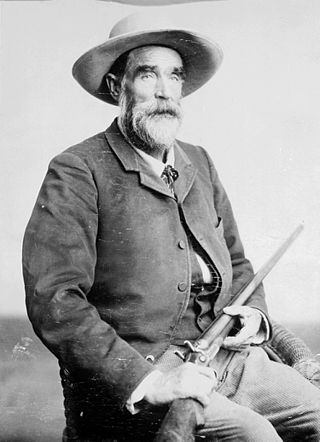
Thomas Jefferson Jeffords was a United States Army scout, Indian agent, prospector, and superintendent of overland mail in the Arizona Territory. His friendship with Apache leader Cochise was instrumental in ending the Indian wars in that region. He first met Cochise when he rode alone into Cochise's camp in 1871 to request that the chief come to Canada Alamosa for peace talks. Cochise declined at least in part because he was afraid to travel with his family after the recent Camp Grant Massacre. Three months later he made the trip and stayed for over six months during which time their friendship grew while the negotiations failed. Cochise was unwilling to accept the Tularosa Valley as his reservation and home. In October 1872, Jeffords led General Oliver O. Howard to Cochise's Stronghold, believed to be China Meadow, in the Dragoon Mountains. Cochise demanded and got the Dragoon and Chiricahua Mountains as his reservation and Tom Jeffords as his agent. From 1872 to 1876, there was peace in southern Arizona. Then renegade Apaches killed Nicholas Rogers who had sold them whiskey and the cry went out to abolish the reservation and remove Jeffords as agent. Tom Jeffords embarked on a series of ventures as sutler and postmaster at Fort Huachuca, head of the first Tucson water company trying to bring artesian water to that city, and as prospector and mine owner and developer. He died at Owl Head Buttes in the Tortolita Mountains 35 miles north of Tucson.

The Apache Scouts were part of the United States Army Indian Scouts. Most of their service was during the Apache Wars, between 1849 and 1886, though the last scout retired in 1947. The Apache scouts were the eyes and ears of the United States military and sometimes the cultural translators for the various Apache bands and the Americans. Apache scouts also served in the Navajo War, the Yavapai War, the Mexican Border War and they saw stateside duty during World War II. There has been a great deal written about Apache scouts, both as part of United States Army reports from the field and more colorful accounts written after the events by non-Apaches in newspapers and books. Men such as Al Sieber and Tom Horn were sometimes the commanding officers of small groups of Apache Scouts. As was the custom in the United States military, scouts were generally enlisted with Anglo nicknames or single names. Many Apache Scouts received citations for bravery.

Chief Naiche was the final hereditary chief of the Chiricahua band of Apache Indians.
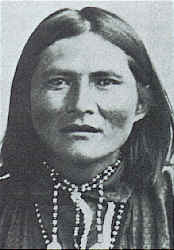
Alchesay, also known as William Alchesay, Alchisay and Alchise, was a chief of the White Mountain Apache tribe and an Indian Scout. He received the United States military's highest decoration for bravery, the Medal of Honor, for his actions during the Indian Wars.

First Lieutenant Charles Bare Gatewood was an American soldier born in Woodstock, Virginia. He served in the United States Army in the 6th Cavalry after graduating from West Point. Upon assignment to the American Southwest, Gatewood led platoons of Apache and Navajo scouts against renegades during the Apache Wars. In 1886, he played a key role in ending the Geronimo Campaign by persuading Geronimo to surrender to the army. Beset with health problems due to exposure in the Southwest and Dakotas, Gatewood was critically injured in the Johnson County War and retired from the Army in 1895, dying a year later from stomach cancer. Before his retirement he was nominated for the Medal of Honor, but was denied the award. He was portrayed by Jason Patric in the 1993 film Geronimo: An American Legend.

Geronimo Campaign, between May 1885 and September 1886, was the last large-scale military operation of the Apache wars. It took more than 5,000 US soldiers, led by the two experienced US Army generals, in order to subdue no more than 70 Chiricahua Apache who fled the San Carlos Reservation and raided parts of Arizona and Sonora in Mexico for more than a year.
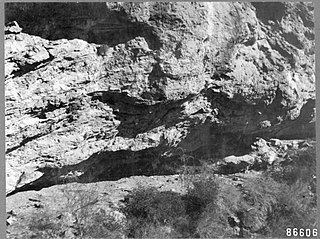
The Yavapai Wars, or the Tonto Wars, were a series of armed conflicts between the Yavapai and Tonto tribes against the United States in the Arizona Territory. The period began no later than 1861, with the arrival of American settlers on Yavapai and Tonto land. At the time, the Yavapai were considered a band of the Western Apache people due to their close relationship with tribes such as the Tonto and Pinal. The war culminated with the Yavapai's removal from the Camp Verde Reservation to San Carlos on February 27, 1875, an event now known as Exodus Day.
The Battle of Devil's Creek was a military engagement during Geronimo's War, fought on May 22, 1885 near Alma, New Mexico. Though it was a minor skirmish, it was the first battle of the Geronimo campaign and ended after the Apaches were routed from their positions.

Chato was a Chiricahua Apache subchief who carried out several raids on settlers in Arizona in the 1870s. His Apache name was Bidayajislnl or Pedes-klinje. He was a protege of Cochise, and he surrendered with Cochise in 1872 going to live on the San Carlos Reservation in southern Arizona, where he became an Apache Scout. Following his service as a scout he was taken prisoner after being coerced to travel to Washington, D.C. Chato was imprisoned in St. Augustine, Florida along with almost 500 other Apache at Fort Marion.
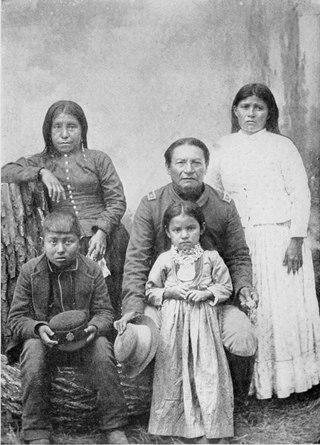
Chihuahua or Chewawa, whose apache name was really (Mescalero-Chiricahua: Kla-esh or Tłá'í'ez ), was chief of the Chokonen local group of the Tsokanende Band of Chiricahua Apache who carried out several raids on settlers in Arizona in the 1870s and 1880s. His elder brother Ulzana, who would later become known as leader of a very famous raid through New Mexico and Arizona in 1885, was his war chief (segundo).
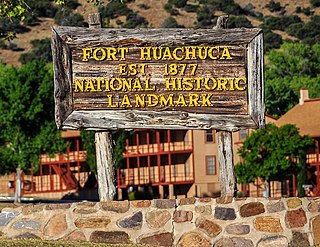
This is a list with images of some of the historic structures and places in the Fort Huachuca National Historic District in Arizona. The district, also known as Old Fort Huachuca, is located within Fort Huachuca an active United States Army installation under the command of the United States Army Installation Management Command. The fort sits at the base of the Huachuca Mountains four miles west of the town of Sierra Vista, on AZ 90 in Cochise County, Arizona.




















